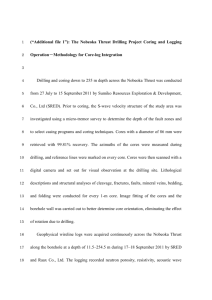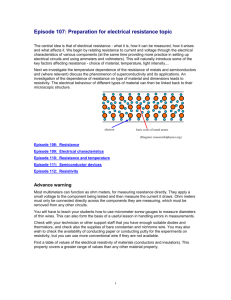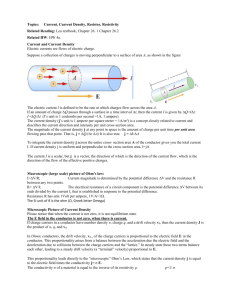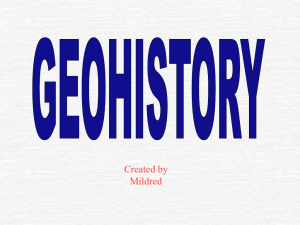1.1 General Introduction
advertisement
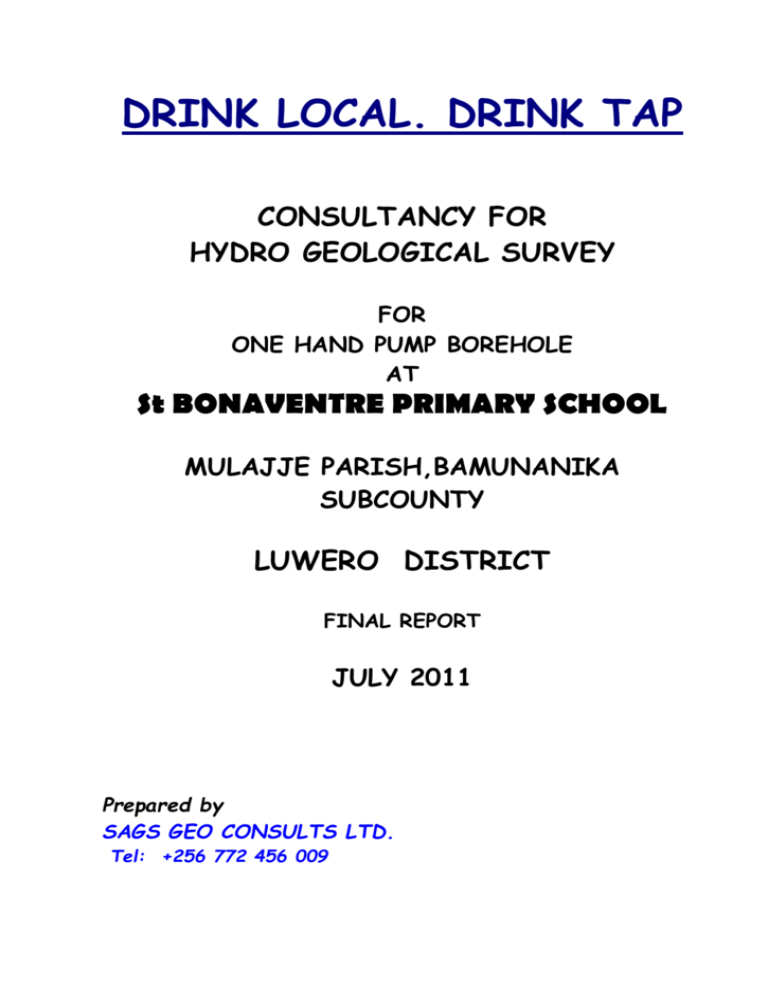
DRINK LOCAL. DRINK TAP CONSULTANCY FOR HYDRO GEOLOGICAL SURVEY FOR ONE HAND PUMP BOREHOLE AT St BONAVENTRE PRIMARY SCHOOL MULAJJE PARISH,BAMUNANIKA SUBCOUNTY LUWERO DISTRICT FINAL REPORT JULY 2011 Prepared by SAGS GEO CONSULTS LTD. Tel: +256 772 456 009 Table of Contents 1. INTRODUCTION ............................................................................................................3 1.1 General Introduction ...................................................................................... 3 1.2 Survey Objective ........................................................................................... 3 1.3 Scope of services ............................................................................................ 3 1.5 Outputs .............................................................................................................. 3 2. General Information .......................................................................................................4 2.1 Location.............................................................................................................. 4 2.2 Drainage and Topography of Nakasongola................................................. 4 2.3 General Geology and Geological Structures .............................................. 4 2.4 Hydrogeology .................................................. Error! Bookmark not defined. 3.0 LITERATURE REVIEW ..................................................................................................1 3.1 Borehole Data ................................................................................................. 1 3.2 Geophysical Data Analysis ............................................................................. 2 4.0 METHODOLGY AND APPROACH................................................................................3 5.0 DETAILED HYDROGEOLOGICAL INVESTIGATION RESULTS......................5 6.0 GENERAL CONCLUSIONS AND RECOMMENDATION ...... Error! Bookmark not defined. Site location and VESes....................................................................................... 15 1. INTRODUCTION 1.1 General Introduction DRINK LOCAL. DRINK TAP is a Local US Organization whose main objective is to assist the less privilege communities in different countries. In Uganda the organization has pioneered by identifying St Bonventure Primary School Mulajje Village, Bamunanika Sub county, Luweero district as a water stressed community who need safe water close to them The Organization has decided to intervene by funding a Borehole Construction around this community to alleviate the water problem This organization procured the services of SAGS GEO CONSULTS LTD a Local consultancy firm, to undertake deep borehole siting and identify a possible water source in the confines or neighborhood of the school which may be drilled for water abstraction. The result of the survey is given in this report 1.2 Survey Objective The overall objective of the survey is to study the ground conditions in and around the school and identify a point that may be drilled with the purpose of abstracting water which will be used by the mentioned community. 1.3 Scope of services The Consultants services will generally cover the following: Borehole siting, including conducting reconnaissance surveys and Preparation of a Siting Report. 1.5 Outputs At the end of the survey, the Consultant should be able to produce a detailed Hydrogeological survey report giving all the findings and identify the point which has the highest ground water potential for drilling. 2. General Information 2.1 Location The survey area is located about three Kilometres from Bamunanika centre which in turn is located about twelve Kilometres from Wobulenzi township. This Township is about fifty Kilometres from Kampala along the Gulu High way. 2.2 Drainage and Topography of Luwero Luweero District where the school is located is generally divided into two distinct topographic regimes. In the south, centre, east and northeast of the district, the topographic relief is higher than in the west, north and central-north of the district. In the former, relief varies from 1076 to 1333 m.a.s.l over much of the area while in the latter; relief varies from below 1045-1106 m.a.s.l over much of the area. In the latter, relief variations are subtler, making the area have a low (flattish) relief with wide open u shaped valleys while in the former, relief variation is quite distinct, with relatively narrower v-shaped valleys. Drainage varies in accordance with the relief variations. In the north west, west and central north, drainage is rectangular to dendritic at the regional level and rectangular at the local level. In the southeast, east, northeast and centre, drainage is generally dendritic. Permanent rivers of regional dimensions bound the district; Rivers Lwajali and Sezibwa to the east, Rivers Lugogo and Lubenge in the north and north east, River Kafu in the north west and rivers Mayanja Kato and Mayanja Waswa in the west. Flow directions of the regional drainage channels are north in the east and generally north west for the rest of the area. 2.3 General Geology and Geological Structures of Luwero 2.3.1 Generalised Geology There is no existing geological map at one scale covering the area of Luweero District. The area of Luweero District is covered by two map series at 1:100000 and 1:250000. The map series at 1:100000 scale are geological maps whereas the one at 1:250000 is a soil map from which the geology can only be constructed. The extreme southern and south western parts of the District are underlain by rocks of the so-called Buganda series while the rest of the district is underlain by granitoid rocks including those of the so-called Basement complex. The former include doleritic and amphibolitic rocks, shales, phyllitic shales, phyllites, injected shcists which are considerably feldspathised and with pegmatite veins and pods while the latter include hornblende and quartz-hornblende gneisses, foliated and unfoliated gneisses and granites and brecciated and veined quartz rock. The rocks of the Buganda series are believed to be metasedimentary rocks. They are predominantly pelitic and have been metamorphosed to from rocks which vary from slightly cleaved phyllitic mudstones and shales to mica schists. Psammitic sediments forming sandstones and quartzites occur at or near the base and possibly as lenses within the sequence. There is also a strong development of amphibolites believed to be derived from volcanic or intrusive basic rocks with occasional outliers. Outcrops of the basement complex are scarce, the area of subsurface coverage being one of low relief and only a few scattered hills provide exposures. Other lithologies lateritic duricrust, alluvial sands, silts, clays, gravels, papyrus residues and river alluvium. 2.3.2 General Structure The tectonics of the area is based largely on structural features apparent in quartzites owing to the poor preservation of outcrops of argillaceous sediments. Foliation is generally NNE in the vicinity of the Buganda series and close to the boundary quartzites it is 0700. 2.4 Hydrogeology Groundwater occurrence – preamble and model for Luweero District Groundwater originates for all purposes from infiltration of rainfall below the root zone, either directly on the soil or in ponds, lakes and river beds. Thereafter, groundwater is found in the pore spaces (voids) between the solid rock (consolidated formations) or solid rock particles. Continuous aquifers are those formations, in which all points are connected hydraulically through a porous medium (sand, gravel, clayey sand, sandstone, etc.,). In unconsolidated and poorly consolidated sediments, the pore spaces are simply the openings between the grains. Weathered rock is in this respect similar to sediments. Discontinuous aquifers are those formations in which hydraulic connections are discontinuous and no correlation is possible from one point to another. They are complex in occurrence and spatially highly variable. Groundwater occurrence in these is exclusively related to weathering or fracturing of the rocks since the matrix of the rock is almost completely impervious. The secondary porosity due to fracturing and weathering permits the flow and storage of groundwater. In the tropical and sub-tropical regions, the weathered and often clayey overburden (regolith) provides the main groundwater storage for the fractured rock. This type of aquifer usually occurs in crystalline rocks like those that underlie the greatest area of the project area. The weathering of fractured bedrock zones results in the development of clayey pockets which have a much lower electrical resistivity than the surrounding bedrock. This geological structure, due to the preferential effect of the weathering on the tectonised axes, can easily be located by electrical resistivity profiles method. In the case of discontinuous aquifers, the amount of water in storage is limited to the fractures and fissures of the bedrock or to small pockets of weathered formation. This amount of water may not be sufficient to supply water to wells for the duration of the dry season and may be very sensitive to the inter-annual rainfall variations with the result that wells dry out during the drought periods. In dry regions where the annual recharge of the aquifer may occur only over its actual extent, which is usually limited to the fractured zones which maybe a few metres wide, where this zone corresponds to the bottom of a valley, it can be recharged from a wider catchment basin. Two types of fracture systems occur in crystalline rock basement systems. Fractures resulting from reduced loading due to weathering/ erosion tend to be sub-horizontal with a decreasing frequency downwards, and those resulting from tectonics movement tend to be sub-vertical and are often found in zonal concentrations. Both are enhanced by the subsequent weathering processes. Water resources potential varies from place to place but on a generalized level, it is possible to delineate areas/zones of low, medium or high groundwater potential, based on the above mentioned facts. The results of Inception studies show that generally aquifers in most parts of the Districts occur in both the saturated overburden and bedrock - as fractures in the bedrock. The overburden is taken to be composed of both the amorphous regolith and the transition/alteration zone that overlies hard, competent bedrock. 3.0 LITERATURE REVIEW Before embarking on any investigations, the Consultant carried out desk studies of some drilled water sources within Bamunanika Subcounty , these were limited in number however for the few that were obtained, some important Parameters are given below 3.1 Borehole Data Bh Depth (m) Depth to Main Water Strike Approximated Yields Aquifer Type VILLAGE VILLAGE KAKIRA KYAMPISI (BAMUNANIKA) 100.7 13.7 5.03 Overburden BAMUNANIKA SEKAMULI LUTETE SEKAMULI KITEME KANGUKI KASIRIBITI BUWEKE GUGABO KAKIIRA LUTETE S.S LUTETE BAMUNANIKA KIBANYI KANSEKA BAMUNANIKA MULANGU KIBIRIZI NKULUZE BUTTO KALEMBA BUKESA SEKAMULI NAKULABYE KYAMPISI (BAMUNANIKA) SEKAMULI KYAMPISI (BAMUNANIKA) SEKAMULI KITEME KIBANYI SEKAMULI KITEME KIBANYI KYAMPISI (BAMUNANIKA) KYAMPISI (BAMUNANIKA) KYAMPISI (BAMUNANIKA) KYAMPISI (BAMUNANIKA) KIBANYI KYAMPISI (BAMUNANIKA) KYAMPISI (BAMUNANIKA) KITEME KIBIRIZI KIBIRIZI KYAMPISI (BAMUNANIKA) MPOLOGOMA KITEME SEKAMULI 129.9 32 25.6 39.7 52.09 53.79 40.12 46.36 55.48 50 62.5 68.6 56.4 63 63 87.3 56.9 80.8 80.8 56.4 56.4 62.5 93 68.6 38.4 19.83 25.6 17.1 28 46 16 23.5 39 7.9 1.02 1.23 0.61 6 3.6 0.8 1.5 1.8 Fractured Bedrock 44.7 50.3 27.8 50.8 44.7 81.2 1.8 0.72 2.1 1 2.4 0.9 Fractured Bedrock 25.2 62.5 25.9 50.3 38.1 62.5 50.3 0.8 0.48 0.9 0.96 1.6 0.2 1.3 Overburden Overburden Fractured Bedrock Overburden Fractured Bedrock Weathered Overburden Fractured Bedrock Fractured Bedrock Fractured Bedrock Fractured Bedrock Fractured Bedrock Fractured Bedrock Fractured Bedrock Fractured Bedrock Overburden Bedrock Fractured Bedrock Fractured Bedrock Fractured Bedrock From the above the following have been observed about the survey area The average drilling depth is 65m, though from experience this appears to be more related with the topographical position of the source The average yield for the successful sources is about 1430 L/h. (Note that this average yield given may have been influenced by some few extremely high yielding sources The mean water strike mostly varies between 35-41m though some exceptionally deeper strikes are encountered Water in this subcounty may be encountered in both the overburden and fractured rock From the above data for the Bamunanika Subcounty, it appears that it is an averagely good ground water potential area. It is important at this point to note such areas may have pockets of extremely low ground water potential 3.2 Geophysical Data Analysis For successful wells, water bearing zones range from 80-170 ohm-m on the sounding curve. On the geophysical profile, there is normally a broad zone of low resistivities (anomaly), 15 – >40m wide, signifying a wide zone of intense, usually relatively deep weathering. On the VES curve, the upper parts of the bedrock have lower resistivities and there is normally a transitional zone between the regolith and the unfractured bedrock though at times, there is just a thick regolith underlying the unfractured bedrock. . 2 4.0 METHODOLGY AND APPROACH 4.1 Detailed Field Surveys 4.1.1 Calibration Soundings Normally during the reconnaissance surveys, resistivity soundings are carried out at existing boreholes within the vicinity of the areas to be investigated. This is for the purpose of better understanding the subsurface geophysical conditions for groundwater occurrence, which could be used as references to good and productive soundings. The Consultant carried out two calibration on one of the functional and the other non functional Hand Pump Borehole 4.1.2 Resistivity Profiling and Soundings Generally, resistivity profiling , under the Schlumberger array of electrodes configuration, was carried out in a roughly perpendicular direction to the general trend of drainage. The profiles were run with a current separation (AB) of 116m and potential electrodes separation (MN) of 10m, usually using a current of 10mA. Station intervals of 10m (Sometimes 8M) were used with the aim of mapping anomalous resistivity zones caused by the presence of fractured zones and/or zones of deeper weathering, which usually are the favorable areas for ground water abstraction. Resistivity profiling allowed the determination of the magnitudes of these areas or zones which manifested during the profiling as major or minor resistivity anomalies. Interesting anomalies were investigated further by Precise Location of Resistivity Anomaly, PLRA and PDRA, which involved the reinvestigation of the anomalous resistivity plane or volume, along and across the profiles, but at 2.5-1m station intervals. The interpretation of the main and PLRA profiles was both qualitative and quantitative. The shapes, contrasts and values of apparent resistivities of the anomaly were analysed and Vertical Electrical Soundings (VES) were then carried out on the points that were considered the centres of the anomalous zones. Resistivity soundings were carried out in directions parallel to the orientations of the inferred lineaments. The Schlumberger array of electrodes configuration was employed to study the electrical properties of the subsurface with depth. A maximum of AB of 240m was used with MNs of 1m and 10m. 3 4.1.3 Site Selection, marking and analysis of results After the detailed investigations, results obtained were plotted on logarithmic paper, analysed and interpreted. The site to drill was chosen or selected on the basis of the most favorable electrical properties of the subsurface for groundwater occurrence, hydrogeological criteria coinciding with the planning criteria, in most of the areas worked in. Concisely put, the choice of best borehole site was also based on of the following site parameters: Size and contrast of anomaly, Topographic and/or hydrogeological setting, Inferred local geostructural setup, Depth and thickness of overburden or weathered zone as per VES shape and apparent resistivity values, Pre-bed rock resistivities, Sanitation conditions and Accessibility. 4 5.0 DETAILED HYDROGEOLOGICAL INVESTIGATION RESULTS Overall lay out of the area St. Bonaventure Primary school is located a few Kilometrtes from bamunanika Centre along Wabusana road,in a clustred community made up of the Mulajje Catholic Parish and Mulajje Secondary school. This is at the base of the imposing Bamunanika hill to the south hence the general slope southwards towards Nkweya valley. The hill is covered by granite outcrops which are capped by laterite crusts. Preliminary investigations identified this area as a low ground water potential area with very shallow Bedrock conditions which do not favor ground water existence. There are some water sources in the neighborhood but the high population of the area and the distance to this source make the community of St Bona venture very vulnerable hence the need to identify another source close to this community. Geophysical investigations The approach used by the consultant was geared at covering the area around the Primary school thoroughly in order to determine the point, unluckily the results were far from promising with very high apparent resistivity values exceeding the desired ranges. Only the most pertinent are given in this report Calibration Boreholes T o fully understand the ground conditions, calibration soundings were carried out at two Boreholes one working and the other abandoned due to extremely low or zero yield in this way both the positive and negative attributes could be identified and be used as guide to achieving the desired results. Calibration sounding 1 This was carried out at a non working Borehole which is located just in front of the Parish Church. There is little information about this Borehole though it appears to be one of the wells that were drilled in the Mid eighties where no Hydro geological survey was carried out. 5 St. BONAVENTURE P/s Calibration VES 01 Apparent Resistivity (ohm M) 1000 100 MN/2=0,5 MN/2=5,0 10 1 10 Distance(m ) 100 The signature indicates that the point has very shallow bedrock conditions not less than 12m, devoid of fractured zone and to with extremely high apparent resistivity values all factors not favoring existence of ground water Calibration sounding 2 The sounding was carried at a working Borehole which is topographically lower than sounding 1. The first observation is the different topographic setting of the two Boreholes with the former being topographically Higher St. BONAVENTURE P/s Calibration VES 02 Apparent Resistivity (ohm M) 1000 MN/2=0,5 MN/2=5,0 100 10 1 10 Distance(m ) 100 The qualities of this signature contrasts the previous ones in the sense that the apparent resisitivity values are very low, less than 100 Ohm-m as opposed to the 300 Ohm-m in the previous sounding 6 Secondly the weathered zone in this signature is fairly thick and the bedrock is not shallow. Available data indicate that this Borhole has a depth of about 55 and installed at 36m, with a yield of 1,200 L/h Profile 01 Targeting the Primary school, this was carried out from the Parish church, past parish Headquarters and above the Primary school. Its length was curtailed by approaching the school toilets which were considered possible source of contamination. The graph below gives the results St BONAVENTURE P/S PROFILE 01 900 Apparent resistivity (ohm-m) 800 700 600 500 400 0 50 Station (m) 100 150 The apparent resistivity values in this profile were found to be way too high above the targeted range of 100-200 Ohm-m and hence no further investigations were carried out along this profile Profile 02 This was carried just below the Primary school along the road direction. While the resisitivity values were slightly lower than the previous ones, too they were way above the expected values as seen in the graph below 7 St BONAVENTURE P/S PROFILE 02 Apparent resistivity (ohm-m) 650 500 350 200 0 50 Station (m) 100 150 However one point noted here was the relationship between the topography and average resistivity values, It was evident that they have an inverse relationship in this area Profile 3 and 4 In order to investigate the topographically lower ground just below the Primary School. This was run from the Parish Headquarters past the school and beyond St Mary church across the road. The Profile length was limited by the boundaries of the Mulajje Church Parish land. The values tended to decrease with topography but none of the values obtained came anywhere near the targeted values as shown in the graph below 8 St BONAVENTURE P/S PROFILE 03 Apparent resistivity (ohm-m) 900 700 500 300 100 0 50 Station (m) 100 150 Profiling west of St Mary Church, the Consultant still encountered high apparent resistivity values in Profile 4. At this point it was becoming very clear that the area of investigation around the Primary school is a low ground water potential area Profile 05 This profile targeted the area around the functional Borehole, with the hope that another water bearing zone would be identified possibly not very near the existing source. The profile was run from where Profile 03 had ended along the same topographic line as the Borehole and past it. Apparent resistivity values were clearly lower than any other encountered 9 St BONAVENTURE P/S PROFILE 05 Apparent resistivity (ohm-m) 450 300 150 0 0 50 Station (m) 100 150 The anomaly which the borehole taps from was identified at station 130-140 m and too another anomaly at station 70-80m was identified. Further investigations led to carrying out a VES in this zone and the signature is given below VES 05/75 The quality of the signature was good with all the desired good qualities however the main limiting factor was its proximity to the existing source. Concerted effort by the Consultant to identify a similar point in the same zone but further from the existing one were futile 10 St. BONAVENTURE P/s VES 05/75 Apparent Resistivity (ohm M) 1000 MN/2=0,5 MN/2=5,0 100 10 1 10 Distance(m ) 100 Profile 7 In reply to the challenge mentioned earlier, the Consultant made an attempt of identifying another potential drilling point and this was by investigating the area further North West of the previously surveyed area. The profile yielded a prominent anomaly at 60m anomalous zone where a sounding was carried out St BONAVENTURE P/S PROFILE 07 Apparent resistivity (ohm-m) 450 300 150 0 0 50 Station (m) 100 11 VES 07/60 St. BONAVENTURE P/s VES 07/60 Apparent Resistivity (ohm M) 1000 100 MN/2=0,5 10 MN/2=5,0 1 10 Distance(m ) 100 This was further improved by finding the centre of the anomaly and carrying out another sounding VES 08/12 St. BONAVENTURE P/s VES 08/12 Apparent Resistivity (ohm M) 1000 100 MN/2=0,5 10 MN/2=5,0 1 10 Distance(m ) 100 The results above also gave a possible drilling point albeit slightly far from the targeted community. The point was however marked by pegging Attempts were made to investigate the zone behind the Secondary school but the results were poor 12 6.0 GENERAL CONCLUSIONS AND RECOMMENDATION The Hydro geological survey has been fully completed and the results can be summarized as thus: The intended beneficiary of his Borehole are St Bonaventure Primary School community , however the ground water potential around the school is extremely low. Two possible drilling points have been identified: one bout 70m from the existing Borehole while the other is about 150 from the Borehole and much further from the school The potential of the former appears to be slightly less than the latter The former source close to the Borehole is viable but may lead to acrimony from outside observers as to why two sources are so close together. The latter is a little out of the way and area is slightly secluded and only close to the Secondary school community though not much further than where the secondary school community gets their water. Way Forward Due to the low ground water potential in the environs of the school, a dilemma is created by the results since non of the sources is very close to the Primary school. The client has several options: i. ii. iii. Drill the site close to the existing Borehole, since it will reduce the congestion on the existing source and is slightly closer to the beneficially community. Drill the site furthest from the School as it too will reduce the stress on the existing Borehole by community in neighborhood and secondary school using it though may not directly benefit the intended community of the Primary school Drill any of the two sites and consider motorizing and pumping the water with a solar driven pump to the school. This raises the cost of the project and also involves maintenance cost. T The point furthest from the school has slightly better ground water potential but being further would be more costly to motorize. 13 For successful construction of the boreholes, the following recommendations will be of much help to the Contractor. Drilling should be done up to an average of 70m in order to penetrate the aquifer fully (Subject to the estimated yield, formation encountered and the decision of the site supervisor). To maximize yields all overburden water should be harnessed using screens and proper gravel packing of the well. The signature shows signs of collapsing formations hence the contractor need to be well equipped About 48-54m and possibly deeper of Upvc casings of which 9m of screens may be required. (this Borehole may require to be constructed with a shallow well design) A yield of approximately 800-1,700 L/h is a realistic expectation from any of the two sources 14 Annex Site location and VESes LOCATION NAME: St Bonaventure Primary School Mulajje Mulajje 457872 VILLAGE UTM Easting Kyampisi 77337 PARISH UTM Northing Bamunanika 1144 SUBCOUNTY Altitude Luwero 05/75 DISTRICT VES No. SITE VES St. St. BONAVENTURE BONAVENTURE P/s P/s VES VES 05/75 05/75 Apparent Resistivity Resistivity (ohm (ohm M) M) Apparent 1000 1000 MN/2=0,5 MN/2=0,5 MN/2=5,0 MN/2=5,0 100 100 10 10 11 10 10 Distance(m Distance(m)) 100 100 GEOPHYSICAL INVESTIGATION SUMMARY: The site is located about 80m from an exisiting source An average drilling depth of 70m is expected with the water bearing zone between 34-48m. Casing depth of 45-51m is expected 15 LOCATION NAME: St Bonaventure Primary School Mulajje Mulajje 458071 VILLAGE UTM Easting Kyampisi 77393 PARISH UTM Northing Bamunanika 1155 SUBCOUNTY Altitude Luwero 08/12 DISTRICT VES No. SITE VES St. BONAVENTURE P/s VES 08/12 Apparent Resistivity (ohm M) 1000 100 MN/2=0,5 10 MN/2=5,0 1 10 Distance(m ) 100 GEOPHYSICAL INVESTIGATION SUMMARY: The site is located furthest from the Primary School An average drilling depth of 74m is expected with the water bearing zone between 38-54m. Casing depth of 52-54m is expected 16 LOCATION MAP Attached to the report separately 17 2




